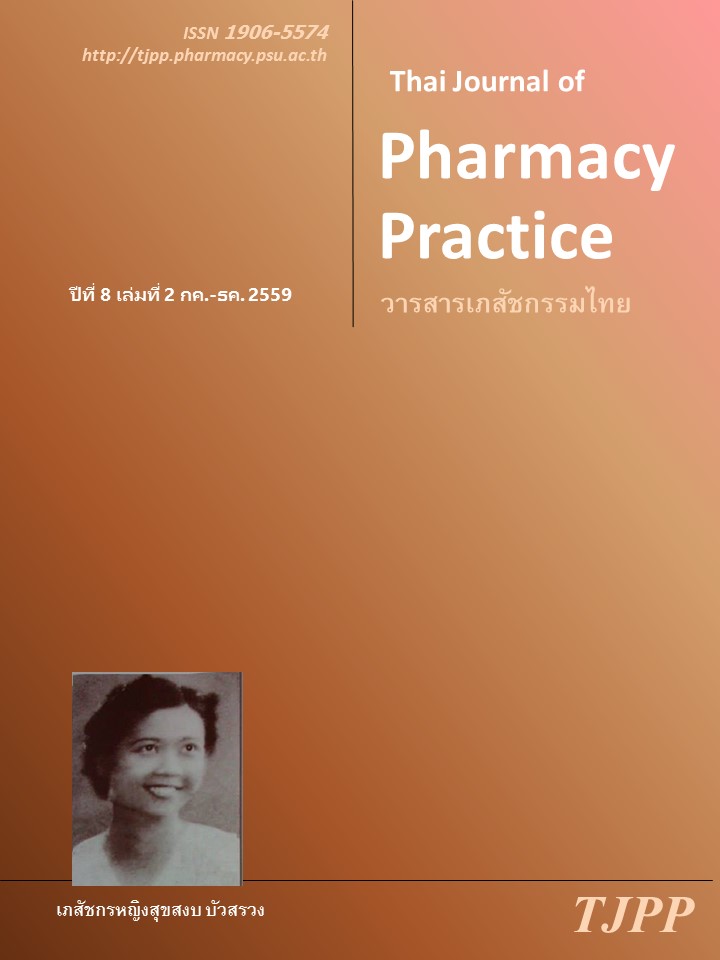ความชุกของการมีสารเคมีกำจัดศัตรูพืชตกค้างในผักจากตลาด และห้างสรรพสินค้าในอำเภอเมือง จังหวัดมหาสารคาม
Main Article Content
บทคัดย่อ
วัตถุประสงค์: เพื่อศึกษาความชุกของการมีสารเคมีกำจัดศัตรูพืชตกค้างในผักจากตลาดและห้างสรรพสินค้าในอำเภอเมือง จังหวัดมหาสารคาม วิธีการ: ผู้วิจัยเก็บตัวอย่างผัก 15 ชนิด ชนิดละ 11-13 ตัวอย่าง รวมทั้งสิ้น 193 ตัวอย่าง ประกอบด้วย กะเพรา ถั่วฝักยาว คะน้า ผักบุ้งจีน ผักกาดกวางตุ้ง มะเขือเปราะ แตงกวา พริกแดง ผักกาดขาว กะหล่ำปลี โหระพา แมงลัก ผักชี ต้นหอม และผักกาดหอม ตัวอย่างผักมาจากตลาดสด 3 แห่ง ตลาดนัด 1 แห่ง และห้างสรรพสินค้า 3 แห่ง หลังจากนั้นวิเคราะห์ตัวอย่างด้วยชุดตรวจสอบสารพิษตกค้างจากยาฆ่าแมลง GT-test kit ชนิดวิเคราะห์ผล 60 นาที หากสารพิษตกค้างยับยั้งการทำงานของเอนไซม์ cholinesterase ตั้งแต่ร้อยละ 50 ขึ้นไป ถือว่ามีสารพิษในระดับที่ไม่ปลอดภัย ผลการวิจัย: ผักตัวอย่างมีสารเคมีกำจัดศัตรูพืชตกค้างในระดับไม่ปลอดภัย 31 ตัวอย่าง (ร้อยละ 16.0) ตกค้างในระดับที่ปลอดภัย 75 ตัวอย่าง (ร้อยละ 38.9) และไม่พบสารเคมีกำจัดศัตรูพืชตกค้าง 87 ตัวอย่าง (ร้อยละ 45.1) เมื่อจำแนกตามชนิดของผัก พบสารเคมีกำจัดศัตรูพืชตกค้างในระดับไม่ปลอดภัยมากที่สุดในพริกแดง (11 จาก 13 ตัวอย่างคิดเป็นร้อยละ 84.6 ของจำนวนตัวอย่างพริกแดง) รองลงมาคือ กะเพรา จำนวน 4 จาก 11 ตัวอย่าง (คิดเป็นร้อยละ 30.8 ของจำนวนตัวอย่างกะเพรา) ผักที่ตรวจไม่พบสารเคมีกำจัดศัตรูพืชในระดับไม่ปลอดภัยคือ ผักบุ้งจีน แตงกวา และผักกาดหอม โดยไม่พบสารเคมีกำจัดศัตรูพืชตกค้างคิดเป็นร้อยละ 62.9, 53.8 และ 46.2 จากจำนวนผักแต่ละชนิด ตามลำดับ สรุป: การศึกษาความชุกของการมีสารเคมีกำจัดศัตรูพืชตกค้างในผักจากตลาดและห้างสรรพสินค้าทำให้ได้ข้อมูลเพื่อเฝ้าระวังสถานการณ์ ผู้บริโภคควรตระหนักถึงอันตรายจากการบริโภคผักที่มีสารพิษตกค้าง หน่วยงานเกี่ยวข้องควรตรวจสอบและเฝ้าระวังสารเคมีกำจัดศัตรูพืชตกค้าง และควรสนับสนุนให้เกษตรกรปลูกผักโดยไม่ใช้สารเคมีกำจัดศัตรูพืช งลอดภัยี thab ราช ุคผักต่อไปีกำจัดศัตรูพืชตกค้าง โดยพืชที่พบสารเคมีกำจัดศัตรูพืชตกค้างในระดับไม่ปลอดภัยเพื่อให้ผู้บริโภคได้รับความปลอดภัยในการบริโภคผัก
Article Details
ผลการวิจัยและความคิดเห็นที่ปรากฏในบทความถือเป็นความคิดเห็นและอยู่ในความรับผิดชอบของผู้นิพนธ์ มิใช่ความเห็นหรือความรับผิดชอบของกองบรรณาธิการ หรือคณะเภสัชศาสตร์ มหาวิทยาลัยสงขลานครินทร์ ทั้งนี้ไม่รวมความผิดพลาดอันเกิดจากการพิมพ์ บทความที่ได้รับการเผยแพร่โดยวารสารเภสัชกรรมไทยถือเป็นสิทธิ์ของวารสารฯ
เอกสารอ้างอิง
2. Bureau of Occupational and Environmental Diseases. Situation of diseases and health hazards caused by occupation and environment 2014 report. Bangkok: Department of Disease Control, Ministry of Public Health; 2014.
3. Sanborn M, Bassil K, Vakil C, Kerr K, Ragan K. 2012 Systematic review of pesticide health effects. Ontario: Ontario College of Family Physicians; 2012.
4. Sanborn M, Cole D, Kathleen Kerr, Vakil C, Helena Sanin L, Bassil K. Pesticides: literature review. Ontario: Ontario College of Family Physicians; 2004.
5. Gwynne L and Andrew W. A review of the role pesticides play in some cancer: children, farmers and pesticides users at risk? London: CHEM Trust; 2010.
6. Office of the Permanent Secretary for Public Health, Ministry of Public Health. Number of deaths by leading cause of death and sex, whole kingdom: 2007 - 2014 [online]. 2015 [cited May 28, 2016]. Available from: service.nso.go.th/nso/ web/statseries/statseries09.html.
7. Public Health Ministerial Declaration in 2011 on Toxic residue foods. Royal Thai Gazette No. 128, Part 59D special (May 26, 2011).
8. Office of Agricultural Economics. Thailand pesticide import value and quantity [online]. 2016 [cited Jun 24, 2016]. Available from: www.oae.go.th/ewt_new s.php?nid=146.
9. Sukamolson S, Sriviriyanuparp W, Kulsomboon V. Priority, prevalence and geographic distribution of unsafe products in Thailand. Journal of Health Systems Research 2016; 37: 65–79.
10. Kumpoopong N. Situation of vegetables and fruits safety in Thailand. In: Pesticides alert conference 2014 [online]. 2014 [cited May 5, 2016]. Available from:www.thaipan.org/sites/default/files/conference 2557/conference2557_20_2_2557_napaporn.pdf.
11. Thailand Pesticide Alert Network: Thai-PAN. Pesticide residues in vegetables and fruits: Monitoring results for 2015. [online]. 2015 [cited Apr 22, 2016]. Available from: www.thaipan.org/ sites/default/files/conference2558/veg2558final.pdf.
12. Prasopsuk J, Saisuphan P, Srisawangwong W. Analysis of pesticide residues in vegetables and fruits for the certification of good agricultural practice in upper northeast Thailand. Khon Kaen Agriculture Journal 2014; 166 supplement 2: 430-9.
13. Bureau of Information. Maha Sarakham health policy forum. Ministry of Public Health [online]. 2015 [cited Apr 20, 2015]; Available from: http://pr.moph.go.th/iprg/include/admin_hotnew/show_hotnew.php?idHot_new=71835.
14. Thoophom G, Sungvaranond B, Jiragobchaiya- pong G, Atlsook K, Jongmevasana P. Test kit for rapid screening residues of pesticide in food. Bulletin of The Department of Medical Sciences 1998; 159: 273–87.
15. Thoophom G. GT pesticide test kit [online]. 2004 [cited 2015 May 6]. Available from: www.gttestkit. com/checking_gt.pdf.
16. Ruangwut C, Kontong P. Pesticide residues in fresh vegetable from markets in Ubonratchathani province. Rajabhat Agriculture Journal. 2011; 20: 22–31.
17. Atisook K, Lertreungdej Y, Suntudrob J, Jongme- vasna W, Payanant T, Orawan Patanakitcharak, et al. Survey of pesticide residues in vegetables, A.D. 2000-2003. Bulletin of the Department of Medical Sciences 2006; 190: 108–20.
18. Sriniwet S. Pesticide hazards. Bangkok: Health Systems Research institute; 2003.
19. Thailand Pesticide Alert Network: Thai-PAN. Pesticide residues in vegetables and fruits: monitoring results for 2016. [online]. 2016 [cited May 6, 2016]. Available from: www.thaipan.org/ sites/default/files/file/pesticide_doc24_press_4_5_2559.pdf.
20. Chaikliang C, Janmanee S, Hnookaw O. Detection of insecticides residues in vegetables from the market in Muang district Suratthani province. In: 50th Kasetsart University Annual Conference: Science, Natural Resources and Environment. Bangkok: Kasetsart University; 2012.
21. Bureau of Food Safety Extension and Support. Food safety situation in Thailand 2012 - 2013 [online]. 2014 [cited Apr 22, 2016]. Available from: www.foodsafety.moph.go.th/s/dl-169/document/Info _general/Food_security_situation___fiscal__2555-2556..doc.
22. Department of Medical Sciences. Reporting project of department of medical sciences 2015. Bangkok: Department of Medical Sciences; 2015.
23. National Bureau of Agricultural Commodity and Food Standards. Agricultural products and foods safety monitoring by ACFS registered laboratories: 2011-2014. Bangkok: National Bureau of Agricul- tural Commodity and Food Standards; 2014.
24. Khemkratoke K, Noumkhuntod P, Khemkratoke U. Main food consumption situation to stipulate food security policy of community: Sumnaktakraw sub - district, Teparak district, Nakhon Ratchasima province. Bangkok: Thailand Research Fund; 2012.
25. Ponthas P, Thongyourn R, Keawmora N, Mongkolsomlit S, Thummajitsakul S, Silprasit K. Health risks of sellers exposed to insecticides in fresh vegetables and fruits in a local market, Nakhonnayok province. Journal of Health Science Research. 2014; 16: 17–24.
26. Ruksilp T. The quantity analysis of organophosphate pesticide residue in agricultural products of Amphur Muang Loei. NU Science Journal. 2004; 2: 61–71.
27. Wanwimolruk S, Phopin K, Boonpangrak S, Prachayasittikul V. Food safety in Thailand 4: comparison of pesticide residues found in three commonly 4 consumed vegetables purchased from local markets and supermarkets in Thailand. PeerJ Preprints [online]. 2016 [cited May 20, 2016]; Available from: https://doi.org/10.7287/peerj.Pre print s.1928 v1.
28. Haitook T, Khanpimon, Lertsansiri K. Study on status of pesticide-free vegetable growing and animal rearing in Ban Swang Sam-ong, Samsoong district, Khon Kaen province. Khon Kaen Agriculture Journal 2015; 169 supplement 1: 721–5.
29. Taweekul K and Boonchan S. Management in chemical free vegetable production of farmer group in Donhan village, Ban Fang district, Changwat Khon Kaen. Khon Kaen Agriculture Journal 2012; 157 supplement: 333–7.
30. Pinthong T. Development Chiang Mai clean vegetable marketing process. Rajabhat Chiang Mai Research Journal 2009; 19: 69-77.


